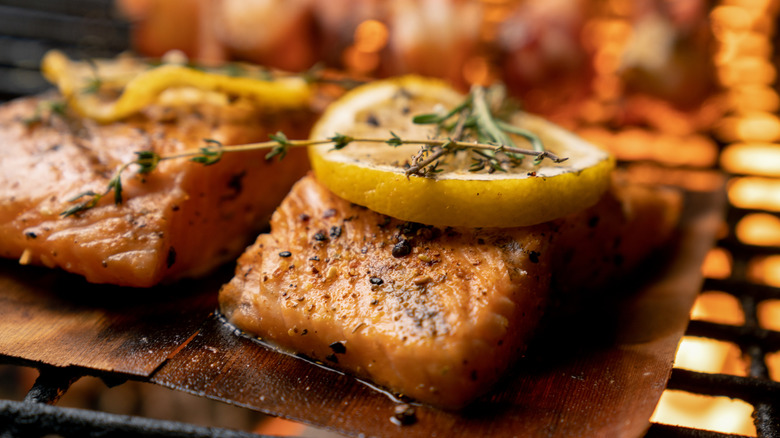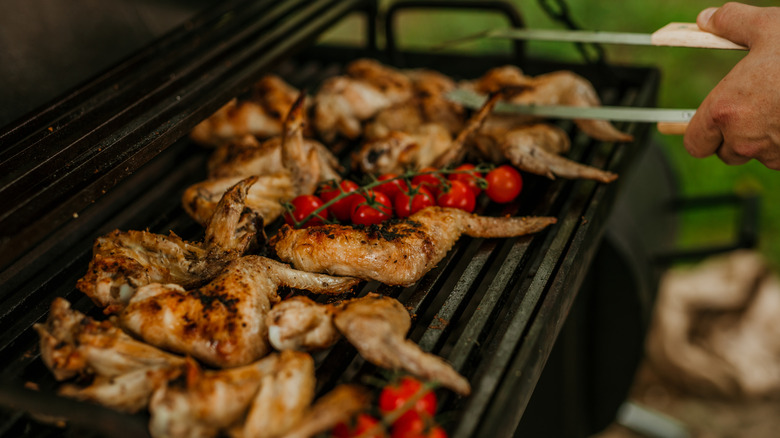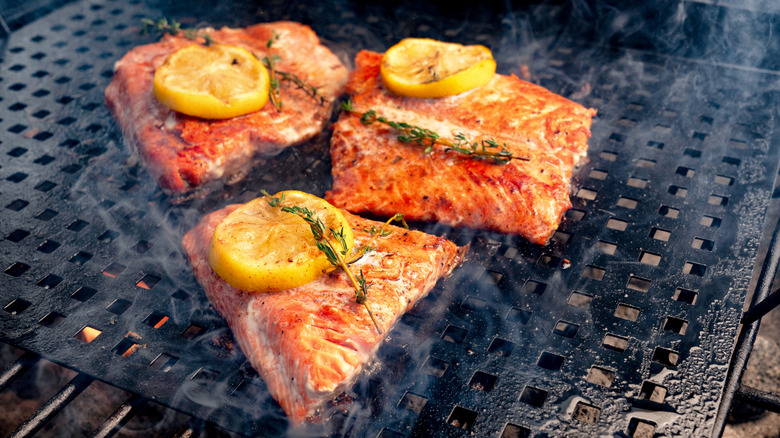Andrew Zimmern's Go-To Technique For Grilling Chicken And Fish
We may receive a commission on purchases made from links.
Grilling and smoking with wood or charcoal is simultaneously cathartic and nerve-wracking. The intricacies of heat zones, charcoal options, and the vagaries of various proteins and veggies make live-fire cooking as much art as it is science. In fact, it's best to approach grilling lighter proteins, like chicken and fish, differently from sturdier steaks and chops. Andrew Zimmern, chef and television personality, is an avid griller and has specific suggestions for the best smoking woods to use with chicken and fish.
Of course, different types of wood serve different functions when it comes to smoking and grilling. Traditional hardwoods like oak and hickory burn slowly and evenly, and produce high, consistent heat, making great charcoal. But on Zimmern's website and YouTube channel, he notes that topping a traditional hardwood charcoal fire with fruitwood chunks or chips like apple, cherry, or plum (often called mild hardwoods for their more subtle flavor influence) will add unique flavors to chicken, fish, or fruit. Understanding how this taste-enhancing heat source works to your advantage to elevate grilled foods is yet another step in learning how to grill like a master.
Fruitwood adds sweet, subtle smokiness
Andrew Zimmern says that he likes using traditional, natural hardwood charcoal as the base for his heat. Natural options, like Kamado Joe's Big Block hardwood lump charcoal, consist of chunks of wood charcoal that haven't been compressed into briquettes. Aficionados prefer lumps because they lack the additives briquettes often possess, and are thought to burn faster, longer, and hotter. Hickory and oak impart a pleasing, smoky scent and flavor to the food, but in this case are used primarily for fuel, not smoke. This is where the fruitwood chips and chunks come in.
"I use fruitwood to contribute flavor and regulate temperature, to a degree, over my natural hardwood charcoal," Zimmern says. He soaks apple or other fruitwood chips in cold water for a half-hour or more, then generously scatters them on top of the hot coals (you can add more every 30 to 60 minutes when cooking low and slow). The moisture steams off, helping chips burn slowly, emitting more smoke, rather than simply catching fire. The same holds true for larger fruitwood chunks, which he soaks for several hours or even overnight. When using the larger pieces for smoking, Zimmern says a soaked fruitwood chunk will burn for about four hours at 250 to 375 degrees Fahrenheit. Alternatively, dry fruitwood chunks can be added to the hot zone (where all the coals are piled) for additional heat, if you're making something robust like a pork shoulder.
How fruitwood smoke impacts chicken and fish
Does fruitwood actually impart a discernible taste to the meat? With naturally mild chicken or fish specifically, it certainly comes in handy. The mild, sweet notes of applewood are definitely discernible on salmon, especially compared with a brash heavy wood like mesquite. Essentially, it's useful to remember that different wood chips will impact meat differently.
Beyond the notable smoky sweetness or fruitiness that fruitwoods lend to the subtle flavors of fish or chicken, many people also believe that fruitwood, particularly cherry wood, influences the color of finished chicken or pork, leaving it a darker red or brown than when smoking with oak. However, this visual effect is practically imperceptible on the dark surface of a well-seared steak.
While Andrew Zimmern focuses on adding fruitwood to hot coals, you can also add natural charcoal to gas grills. First, check to see if your grill has a dedicated box or drawer for wood chips. Alternatively, you can place the chips in something like the Grillaholics smoker box, which sits on top of the hot grill. You can also make a DIY container out of aluminum foil, which is a great way to basically turn any grill into a smoker.


